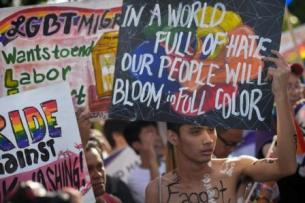A major concern among non- heterosexual persons and communities is the insensitivity of the press , when it comes to reporting on LGBTQIA issues. As far as mainstream press reporting in India is concerned, in most cases, journalists are not even aware that that are being insensitive.
Queer Chennai Chronicles and The News Minute have collaborated on a ‘style guide’ for journalists that will facilitate more sensitive reporting about members of the LGBTQIA+ community and the issues they face.
The first part of the document, titled ‘LGBTQIA+ Media Reference Guide’, was released on Wednesday, the first of June, which started off the Pride Month.
It contains a basic a glossary of terms related to sex, gender and sexuality; suggestions for reporters while covering stories concerning the LGBTQIA+ communities; and guidelines for editors who are commissioning opinion pieces on these communities.
“The representation of LGBTQIA+ persons in the news media in India is often incorrect, derogatory, ignorant, and lacking in perspective. When LGBTQIA+ persons point out mistakes to journalists however, one of the common responses we get is that they didn’t know what the right terms to use were, that they didn’t realize certain depictions were problematic,” the introduction to the style book says.
A chapter is also dedicated to reporting instances of crime where the victim or the perpetrator is from the LGBTQIA+ community.
Here are some extracts:
Gender Identity
‘Gender Identity’ refers to how an individual defines their own gender. It depends on a person’s deeply feltinternal experience of gender. It need not correspond to the sex assigned to the person at birth, and theexpectations that society has from this assigned sex or associated gender. ‘Gender Identity’ is self-determined— that is, only an individual has the right to determine what their gender identity is. There is no ‘medical test’for gender identity. For instance, a transgender man, or transgender woman, or a non-binary person, are theonly ones who can say what their gender is.
Gender expression
Gender expression is how a person expresses or presents their gender. This can include behaviour andoutward appearance such as dress, hair, make-up, body language and voice. A person’s chosen name and pronouns are also common ways of expressing gender.Gender expression does not automatically correspond to one’s gender identity.
For instance , a woman may dress in pants and shirtsand have short hair – generally related by society to a‘man’s’ gender expression. Another example: A person assigned male at birth who wears a saree isn’t automatically a transgender woman. They may still identify as a man, or as non-binary, or any other gender identity.
The word ‘transgender’ is to be used as an adjective. That is, don’t use the terms ‘a transgender’ or ‘transgenders’. Always use transgender person(s), trans person(s), transgender woman, trans woman,transgender man, trans man etc, as per context.
Gender non-conforming person
People (adults or children) who do not conform to either of the binary gender definitions of male or female, as well as those whose gender expression may differ from standard gender norms. In some instances, individuals are perceived as gender non-conforming by other people because of their gender expression. However, these individuals may not perceive themselves as gender non-conforming. Gender expression and gender non-conformity are clearly related to individual and social perceptions of masculinity and femininity.
Transgender person
A transgender person is someone whose gender identity does not match with the sex they were assigned at birth. People assigned male or female at birth, and intersex persons, can be transgender. A person is transgender whether or not such a person has undergone gender affirmation procedures like hormone therapy or surgery. This is re-affirmed in the Supreme Court NALSA verdict (2014) and Transgender Persons (Protection of Rights) Act.
“The guide has been created keeping journalists in mind. This is not an academic document — this is an easy to use reference guide for journalists on the go. We have separate chapters for different ‘beats’ and editorial roles, so that journalists who are usually pressed for time can quickly refer to the section that is relevant to them when they’re working on their stories,” said Ragamalika Karthikeyan (he/she), editor, special projects and experiments at The News Minute. The remaining chapters will be released soon, she said.


